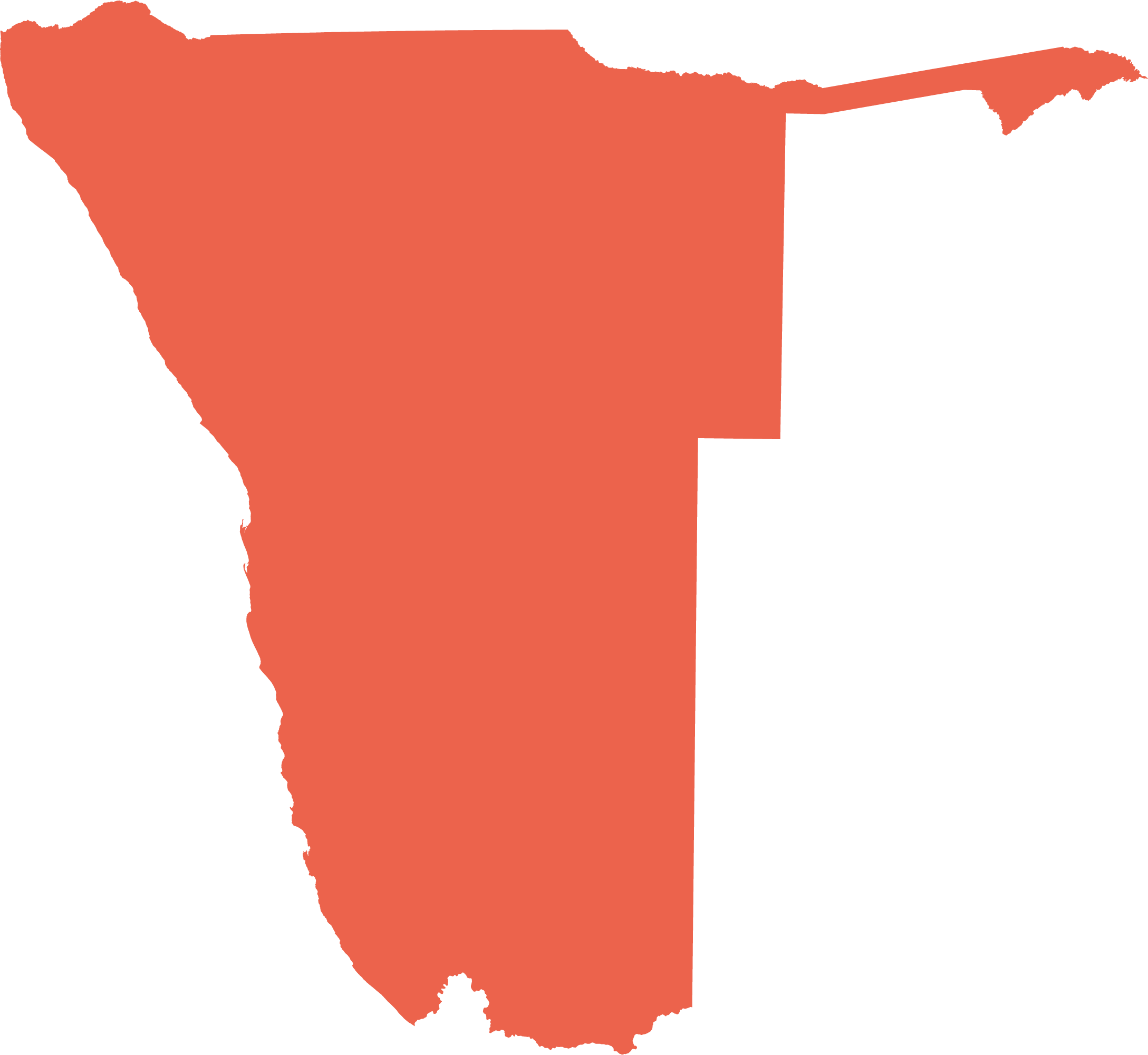Plant richness, endemism and floristic groups4
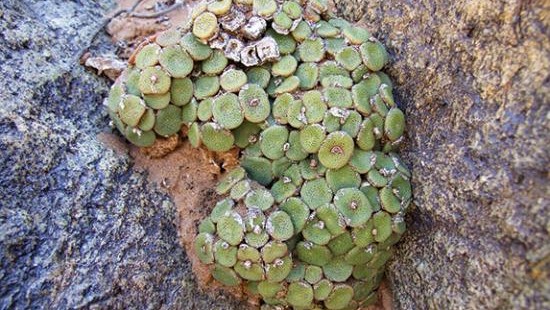
Photo: H Kolberg

Photo: H Kolberg
Succulent plants are found in many different forms, like the small Conophytum ricardianum (first photo above) and the large Aloe gariepensis (second photo above).
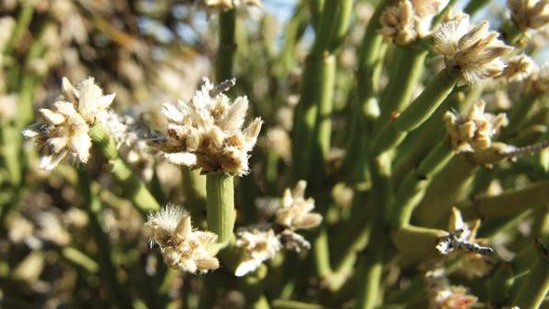
Photo: H Kolberg
The genus Arthraerua is endemic to Namibia and its only species, A. leubnitziae, occurs in the central Namib.

Photo: H Kolberg
The endemic geophyte Rhadamanthus namibensis survives dry years as an underground bulb and appears above ground only after good rainfall.
For the most arid country in sub-Saharan Africa, Namibia has a surprising number of indigenous plants in a large variety of families, genera and species. Over 4,000 species, subspecies or varieties of plants are known so far, and new research will add more. The largest families are the grasses (Poaceae, 387 species), daisies (Asteraceae, 384 species), legumes (Leguminosae, 324 species), vygies and their allies (Aizoaceae, 234 species) and the oleanders (Apocynaceae, 166 species). Many of them are endemic – species that only occur here. Our endemic flora is thus also rich and diverse, consisting of at least 660 species, subspecies or varieties. About another 400 species extend just over the borders into adjacent and localised areas in South Africa or Angola.
Namibian plants have many different growth forms varying from upright trees (almost 300 species) to about 500 species of succulents of all shapes and sizes, and more than 300 species of geophytes which are generally only seen after rain. Namibia's plants are a valuable resource with local uses known for more than 1,000 species. More than 500 listed species are protected by legislation – Namibia's Nature Conservation Ordinance 4 of 1975 and Forest Act 12 of 2001, and the Convention on International Trade in Endangered Species of Wild Fauna and Flora, CITES – while 48 taxa have been provisionally evaluated as 'threatened' using criteria of the International Union for Conservation of Nature (IUCN).
Namibia is fortunate in having comprehensive inventories and collections of plants that provide basic information on the distribution of its flora. The maps in figures 6.05–6.08 show the numbers of plants recorded in quarter-degree squares, each of which covers an area of about 25 x 25 kilometres, while the map in 6.08 provides an analysis of plant distributions. Only higher plants (spermatophytes, gymnosperms and angiosperms) have been included in figures 6.05–6.08 because information on the distribution of lower plants (mosses, ferns, etc.) is inadequate. Gaps on these maps may be due to the absence of certain plants or to a lack of research in those areas. These maps can be useful in highlighting areas where more information is needed.
6.05 Plant diversity
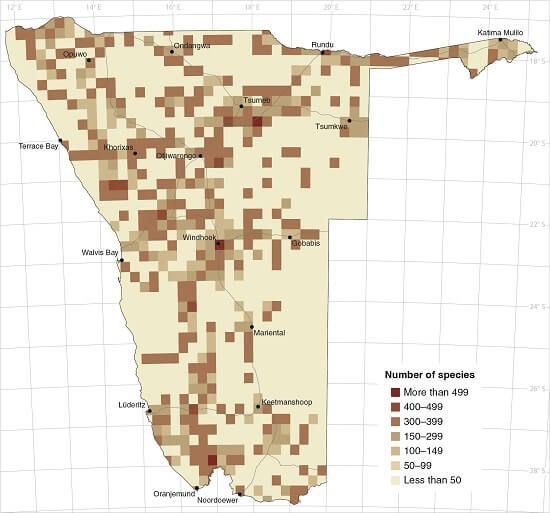
Areas with the highest number of species are dispersed throughout the country, often in localised areas where several different habitats are found close together, or in areas of transition between major habitats or climates. Many of these areas are associated with highlands or isolated hills because of their varied microhabitats (relief, slopes, soils and rocks). The Namusberge north of the Orange River between Oranjemund and Noordoewer provide a good example of this where the plains lead into mountains, fog penetrates up into the valleys and rain may fall in any month.

Photo: H Kolberg
Mountains, such as the Namusberge in southern Namibia, provide many microhabitats for a variety of plants.
6.06 Endemic plant diversity
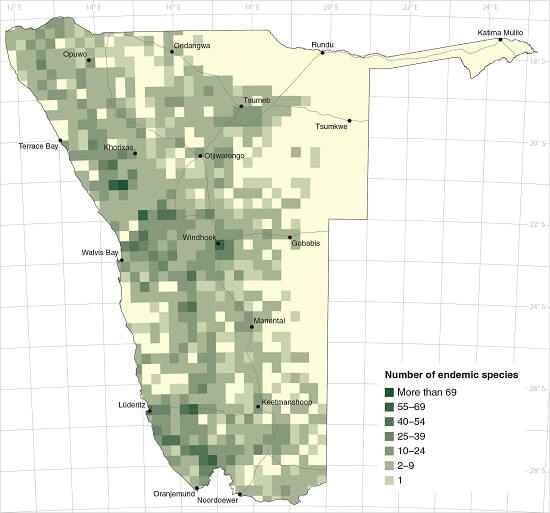
As is the case elsewhere in the world, Namibia's endemics are most abundant in areas associated with variations in altitude, substrate or topography, which provide numerous microclimates. Highlands of importance for endemic plants include the Brandberg, Khomas Hochland, Karas Mountains, western escarpment, and the numerous inselbergs in the southwest. Many endemic plants are also associated with a specific or isolated substrate, such as the limestones of the Otavi–Grootfontein–Tsumeb hills or the granites of the Brandberg.
Some endemic species are widespread, but others occur in very limited areas (figure 6.07). Certain life forms of endemics may be concentrated in particular areas too. For example, the endemics of the southwestern parts of Namibia are mainly succulents while further inland, east of the Huns Mountains, endemic dwarf shrubs are more common. The Kaokoveld is the only area in Namibia with a few endemic trees.

Photo: H Kolberg
Some localised endemics prefer specific substrates, such as the aquatic Chamaegigas intrepidus that occurs only in seasonal pools on granites.
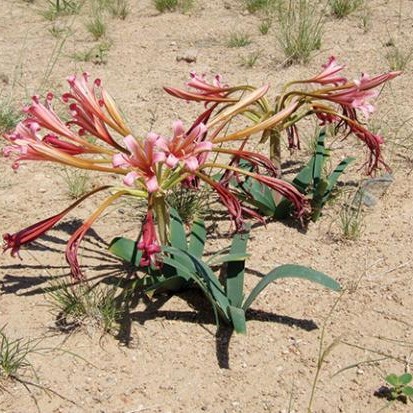
Photo: H Kolberg
This endemic bulbous plant (or geophyte) Ammocharis deserticola, was described only recently and is limited to a small area in the central Namib.
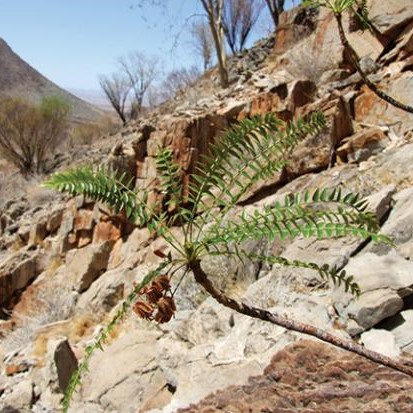
Photo: H Kolberg
Kirkia dewinteri is one of the few endemic trees found in the northwest of Namibia.
6.07 Localised endemic plant species

This map shows the number of endemic species that occur in no more than two adjacent quarter-degree squares. These endemic species have extremely localised distributions, usually occur in small numbers and are adapted to the specific environmental conditions in these areas. They therefore have particular conservation value. The majority are found in western Namibia, but also in the central regions associated with high elevations.

Photo: H Kolberg
The localised endemic Hibiscus discophorus occurs only in the central highlands.

Photo: H Kolberg
Hermannia merxmuelleri is confined to the Brandberg.
6.08 Floristic groups

The geographic distributions of many unrelated plant species overlap in ways that suggest that they share similar origins, for example having evolved at similar times or in similar areas and/or environmental conditions. Most of Namibia's 4,000 plant species can be classed into nine floristic groups, each with a similar evolutionary history. These floristic groups differ from those of vegetation types (figure 6.02) in which plants share ecological requirements and growth forms. Each floristic group has plants endemic to it, as well as species that occur only here and then outside Namibia. The grouping of plants in the cream-coloured area of the map has yet to be understood.
Up to 200 species co-occur in the Welwitschia Desert group, over 150 in the Southern Succulent Desert group and at least 100 species are confined to the Huns–Orange group. Evidence suggests that the Huns–Orange group contains the oldest flora of Namibia (from more than 20 million years ago) followed by the Welwitschia Desert (17 million years ago).
Certain plants in Namibia also occur, or have close relatives, in separate populations in eastern southern Africa and northeast Africa. The same is true for many animals, such as oryx and ostriches. All these organisms were probably once continuously distributed between these areas.
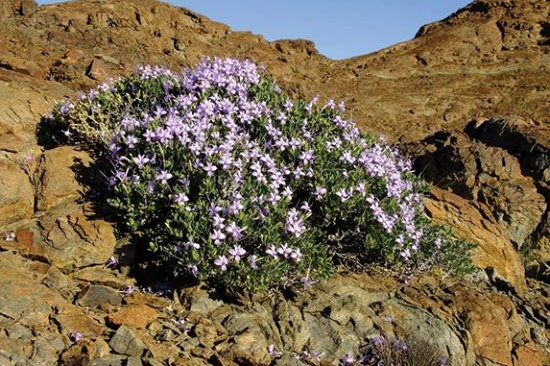
Photo: H Kolberg
Barleria solitaria forms part of the Welwitschia Desert floristic group.

Photo: H Kolberg
Succulent species, such as Hartmanthus pergamentaceus, are part of the Southern Succulent Desert floristic group.
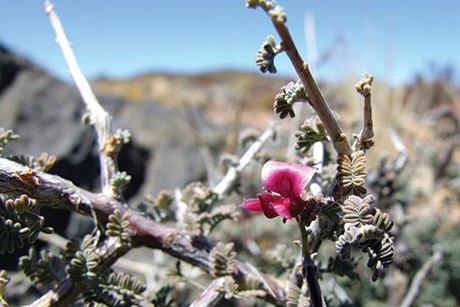
Photo: H Kolberg
Indigofera merxmuelleri is found in the Huns–Orange floristic group.

Photo: H Kolberg
Tribulocarpus dimorphanthus is closely related to plants that occur in both southwestern and northeastern Africa
